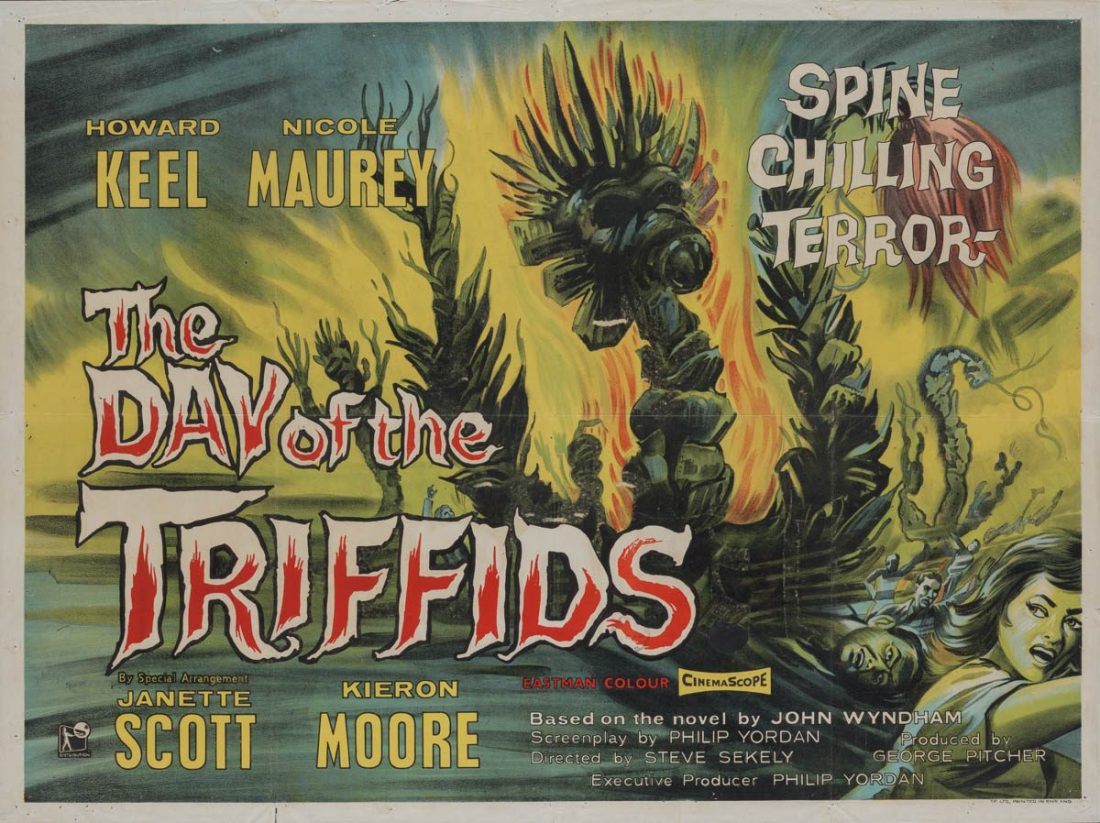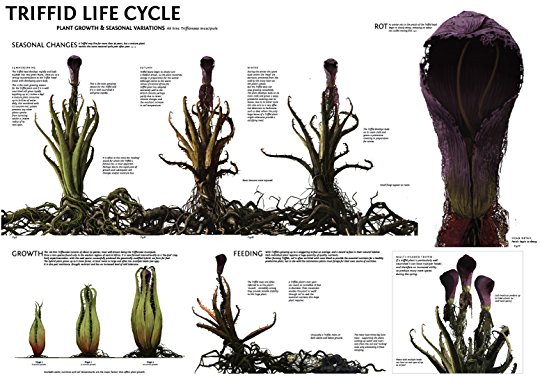
In 1951, John Wyndham published his novel The Day of the Triffids to moderate acclaim. Fifty-two years later, this horrifying story is a science fiction classic, touted by The Times (London) as having “all the reality of a vividly realized nightmare.”
Bill Masen, bandages over his wounded eyes, misses the most spectacular meteorite shower England has ever seen. Removing his bandages the next morning, he finds masses of sightless people wandering the city. He soon meets Josella, another lucky person who has retained her sight, and together they leave the city, aware that the safe, familiar world they knew a mere twenty-four hours before is gone forever.
However, to survive in this post-apocalyptic world, one must survive the Triffids, strange plants that years before began appearing all over the world. The Triffids can grow to over seven feet tall, pull their roots from the ground to walk, and kill a man with one quick lash of their poisonous stingers. With society in shambles, they are now poised to prey on humankind. Wyndham chillingly anticipates bio-warfare and mass destruction, fifty years before their realization, in this prescient account of Cold War paranoia. — Goodreads

The Day of the Triffids is a classic staple in the Sci-Fi genre originally published in the 1950’s. Despite its prevalence in the sci-fi genre, I went into this book with very few preconceptions. Other than the name and knowing that there was some sort of calamity involving plants called Triffids that were dangerous to humans, I knew nothing about this story. There is the tickle of a memory in the back of my mind of the ‘iconic’ sound made by the Triffids in the BBC film of the 1960’s but I again know nothing of the adaptations (hope to remedy this soon).
Even without preconceptions, I went into this story with some anticipation about what might happen. I made a point of not doing any research into this tale before I read it. However I somehow got it into my head that this book was going to be reminiscent of a modern day zombie tale (just replace the zombies with some killer plants), with a focus on the killing of people by the title-carded Triffids. To draw a parallel from my original zombie expectations, this story is more of a Walking Dead rather than Dawn of the Dead, with the focus on the struggles to survive an apocalyptic event rather than the chaos of a dangerous entity (zombies or Triffids).
The apocalyptic event that sweeps the globe, a plague of sightlessness caused by lights from a meteorite shower is a terrifyingly plausible event. We humans are very visual creatures. Even in our modern age where we have improved our understanding of a disability such as sightlessness the thought of the majority of the population of the world blinded so suddenly is problematic to say the least. London is devastated within one day of the epidemic and this story spans a significant amount of time.

The mystery maintained about the Triffids, coupled with the focus on human survival in extreme situations is what made me fall in love with this book. The Triffids have been present for years before the incident, but in spite of them being purposely grown, for decorative, commercial and scientific purposes, very little is known about these things. Two of the only facts confirmed about these plants is that a direct sting from one can kill a full-grown man, and that they seem to ‘eat’ those that they kill. They are actively predatory, able to ‘walk’ quite freely if not staked to the ground and when humans are blind, they stand little chance against these deadly plants. Wyndham never reveals where the Triffids come from or how they spread so quickly. There are theories proposed by various characters but we never find out for sure. I think this serves to make them all the more terrifying and worse, plausible.
I found that the more detailed focus on the human element of the story posed some very interesting moral dilemmas for the cast. With only a handful of people now able to see, questions arise about how, and even if it is possible or desirable (morally and personally) to help those who are blinded. A few survivor groups form throughout the novel with various philosophies, tactics and outcomes and each one’s story is gripping. I still find myself questioning how different the depictions of the various groups would be if the novel was re-written for modern times. Would we be more or less likely to cope if we were to wake up tomorrow on the Day of the Triffids?